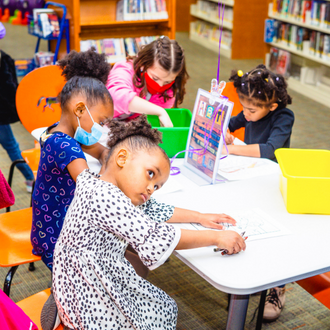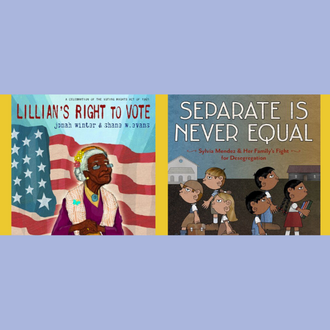Children’s Literature Opens the Door to Conversations About Identity, Race and Equity
By Jinnie Spiegler, Director of Curriculum and Training, Anti-Defamation League
We are at an important moment in our nation’s history. Conversations about hate and bias have become commonplace as we watch, discuss and grapple with incidents large and small: in Charlottesville, Va., we saw the largest and most violent gathering of white supremacists in decades; their have been recent mass shootings targeting religious groups in Charleston, S.C., Pittsburgh and New Zealand; hate crimes are on the rise for the third consecutive year; and bias incidents are proliferating in K-12 schools.
These topics are in our public conversations and have seeped into the minds of even the youngest among us. In a 2018 survey of principals, almost 90 percent reported that incivility and contentiousness in the broader political environment has considerably affected their school, with more than eight in 10 stating that their students have made derogatory remarks about other racial or ethnic groups. Issues of bias, racism and equity have never been more central, and for those with young people in their lives, it is essential to discuss these issues early and often.
Indeed, when an incident occurs — whether ordinary or extraordinary — the central question on parents’ and educators’ minds is: What should we tell the children?
Issues of bias, racism and equity have never been more central, and for those with young people in their lives, it is essential to discuss these issues early and often.
Children’s Development on Identity, Race and Bias
From a very young age, children develop an understanding of identity. By around age two, children are curious about the physical aspects of themselves and others, including race and gender. By ages three and four, they can identify and match people according to “racial” physical characteristics and begin to take in societal stereotypes from people and media; they may show discomfort or fear around differences. A recent study of four-year-olds reveals that there was a “strong and consistent pro-white bias” among racially diverse children. Teachers also play a role in perpetuating bias even at this young age. A 2016 Yale Child Study Center brief shows a tendency of pre-K educators “to more closely observe black students, and especially boys, when challenging behaviors are expected.”
And yet there is hope. According to early childhood and anti-bias expert Louise Derman-Sparks, young children “have a strong sense of empathy and interest in fairness and can begin to develop critical thinking about hurtful images, comments and behaviors.”
We see that young children understand aspects of identity and race and are also absorbing stereotypes and bias. Therefore, it is our responsibility to bring those issues and conversations to the fore in order to dispel stereotypes, expose children to different people and perspectives and impart the tools and mindset to do something about the injustice they see in the world. For these reasons, and because of the increasing demographic shift in the U.S. (as of 2015, more babies of color compared to white babies were born), it is critical that we invite young children to these conversations about race and equity.
Because reading with children is a cherished activity for adults and children and it is a key component of their literacy development, children’s literature is a powerful tool to discuss identity, race, injustice and equity.
Children’s Literature as a Powerful Tool
Using children’s literature is one way to open that door.
Because reading with children is a cherished activity for adults and children and it is a key component of their literacy development, children’s literature is a powerful tool to discuss identity, race, injustice and equity. In ADL’s anti-bias trainings, participants explore their identity, reflect on differences and how that impacts communication, seek to understand and then challenge bias and consider actions they can take to advance equity. These same concepts can be brought to shared reading and literacy conversations between children and adults.
Books about identity, “mirrors and windows,” help children see themselves (mirrors) and learn about people who are different than they are (windows). As Denene Millner says, it is important to read “stories about the everyday beauty of being a little human being of color.” Books about people, identity and culture that serve as mirrors and windows tell these stories — books such as Jabari Jumps; You Hold Me Up; Mango, Abuela and Me; Lola at the Library; Laila’s Lunchbox; A Morning with Grandpa and many more.
As we move into helping children understand and challenge bias, children’s literature offers many excellent selections including Lillian’s Right to Vote, Jacob’s New Dress, March, When We Were Alone, Mama’s Nightingale: A Story of Immigration and Separation, Maddi’s Fridge and Stella Brings the Family, to name just a few.
As we reflect with children on actions people can take to fight for equity, there are many books that tell that story which can inspire children to envision their role in it: The Smallest Girl in the Smallest Grade, Separate Is Never Equal: Sylvia Mendez and Her Family’s Fight for Desegregation, Enough: 20 Protesters That Changed America, I Dissent, We March and many more.
Although there are many great books about people of different cultures, races and identities, there is a still a wide diversity gap in children's literature for books written by people of color and those that feature characters and stories about people of color. We have to push ourselves to find them and insist on using them as part of the classroom curriculum and read-alouds in the home.
As you read the book together or independently, ask open-ended questions to develop and deepen children’s understanding of the book, foster empathy and pull out the important messages.
Choosing Books and Discussion Questions
As you read these and other books with children, there are some important considerations in selection. First, not only is it important to choose books with themes of diversity and equity, but also the books must be engaging for children. An ideal book selection would have a theme that is complex and nuanced, and at the same time has a clear message. The plot should be compelling for a child, with a story arc that includes some conflict or struggle. There should be a myriad of multi-faceted and non-stereotypical characters. And in the case of picture books, the illustrations should be captivating and help to tell the story. Be mindful that sometimes books about “social issues” can be overly moralistic and simplistic or strive to “teach a lesson” that can come off in a judgmental way at the expense of a good plotline; these are books you should avoid.
As you read the book together or independently, ask open-ended questions to develop and deepen children’s understanding of the book, foster empathy and pull out the important messages. Whether you discuss the book with a class of students or at home reading aloud, consider some of these open-ended questions that will advance their thinking:
- How did you feel while reading the book?
- What characters could you relate to and why?
- What did you learn about people who are different than you?
- How do you think you might feel if you were in the character’s situation?
- What do you think is the message of the book?
Any adult who has read with a child knows the experience has a lasting impact. Combine this beloved activity with the important conversations around race and equity and then explore a child-level action you can take together. This will help children think critically about the world around them and reflect on what they can do to change it for the better.
Jinnie Spiegler is the director of curriculum and training at ADL where she creates anti-bias and bullying prevention training and curricular resources. Her professional interests include project-based learning, current events and civics education, children’s literature and social justice education. Jinnie has worked for over 20 years in the field of K-12 education for both NYC-based and national educational organizations.
Related Articles

Lexington Public Library & Luna Library: Celebrating and Creating Black History
Lexington Public Library
Learn more about the launch of the Luna Library, a special collection of children’s books within LPL’s catalog featuring titles by, for and about Black people named in memory of Kamaria Spaulding.
Learn More

Picture Books Can Open Doors to Tough Topics
Anti-Defamation League
Discover how libraries can use picture books to convey important lessons about aspects of identity and the diversity of our society, how to be inclusive, the ways in which bias and injustice permeate our lives and institutions and how to stand up for equity and justice.
